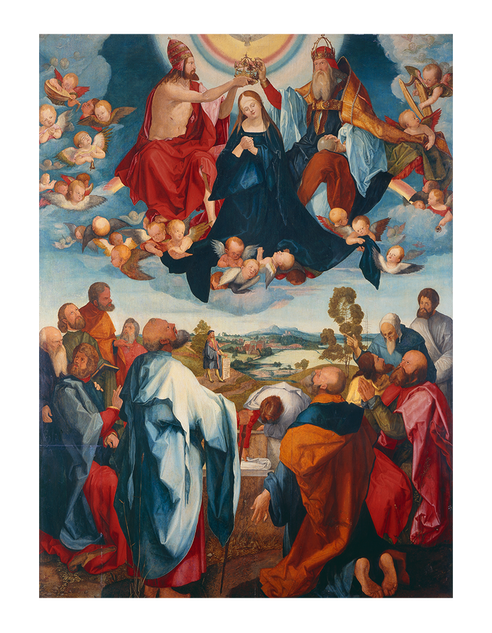“Imagine if a composer of complex symphonies, or a writer of novels, suddenly stopped work while at the top of their game.” A hypothetical Beethoven calling it quits just before his Fifth Symphony; a parallel-universe Cormac McCarthy throwing in the towel before The Road. It’s a sad vision of creativity stymied in its prime; a nearly great artist who, for some reason or another, turned their back on their talent. It’s not a description that anyone would ever imagine applying to an artist who is said to have “shaped the European Renaissance north, south, east and west,” and to have produced work “so fine and inventive that no one since has been able to rival [it].”
That is, until Ulinka Rublack’s dense, scholarly but nonetheless illuminating work, Dürer’s Lost Masterpiece. In her hands, the narrative of Dürer’s success—the master engraver; the artist who fought for recognition for the Northern Renaissance; the pioneer of print culture—becomes something far more nuanced: “There is a different way to look at Dürer’s story,” she tells us. By focusing on a now-lost altarpiece (one of his “best but least-known” works), Rublack shows us a “scarred and angry” Dürer, a shrewd painter who had “fought a historical battle to assert the value of art”—and lost. After 1511, Dürer never again made another altar painting.
Albrecht Dürer’s father was one of “Nuremberg’s master goldsmiths”, a Hungarian immigrant who had every reason to hope that his talented son would join his workshop. At the age of 15, though, Dürer went his own way: he was apprenticed to the painter and printmaker Michael Wolgemut, and the career of the boy who “wanted to become the greatest German of all time” could begin. One of his earliest self-portraits—drawn in silverpoint when he was only 13—more than proves that he was right to follow his convictions: from thin lines scratched on the white background, the young Dürer managed to create depth, shadow and far more texture than might be expected in a child’s face.
These types of drawings—both from his apprenticeship and his later career—are now what Dürer is, in Rublack’s words, “overwhelmingly remembered” for. With his woodcuts and engravings, he is the “master of the black line”, noted for his early adoption of print (the collected version of his 1498 end-of-days sequence Apocalypse is “the first book ever created and printed by an artist”), as well as for his ability to make ink and paper somehow tangible, somehow even sexy. His The Bath House (circa 1496)—a scene of naked men at a communal bath—is an electric mix of the humorous and homoerotic.
But, Rublack tells us, this view of Dürer’s art is partial, and leaves out some of his most innovative, dramatic work. Before 1511, Dürer had painted 10 altarpieces. Prior to the age of museums and galleries, churches were “the most exciting contemporary art spaces”, where “practitioners and connoisseurs travelled to see” masters and up-and-coming painters alike. In 1507—just after Dürer had painted an altarpiece for the cosmopolitan church San Bartolomeo di Rialto in Venice—he received a letter with an exciting commission from Jakob Heller, a Frankfurt merchant. For the next two years, Dürer worked on the most ambitious and taxing project of his life, made only more intense as the artist and the patron fought a battle of wills.
Rublack’s description of the relationship between the two men is vivid and light-footed. “Imagine Jakob Heller as a small astute businessman energetically entering a room wearing a black cloak,” she urges us compellingly. “Money had made this man.” But the storybook touches do little to lighten the overall drama. Heller—an ageing businessmen in his forties, and without children to carry on his line—asked Dürer to paint him an altarpiece that would commemorate him and his wife, Katharina. With their near-inexhaustible mercantile riches, and in keeping with the religious culture of Frankfurt at the time, the couple turned their money into memorials. In Heller’s will, there were provisions for: a man who would be paid to impersonate him and make a pilgrimage across Europe; prayers to be said every Sunday; requiems said every Monday; and masses for every day of the week.
Dürer’s altarpiece was to be a part of this. The ornate, colourful scene of the Virgin Mary’s assumption was to be placed within the Dominican monastery where the couple’s remains would also find rest—and was to be the focus of all the memorial attention.
There was only one problem: in a work that was intended to commemorate the holiness of his wealthy patrons, Dürer added another character to the scene. When Heller unwrapped his precious piece, he would have seen a “lean, isolated figure in a landscape” just below Mary and Jesus, at a point where no viewer could miss him. In one hand, this long-haired man holds a sign: “Albertus Dürer the German was making this in the year since the Virgin gave birth 1509.” It is, of course, Dürer himself. “Dressed like a man of fashionable comportment”—and brightly noticeable in blue silk, compared to the dark robes of his two patrons—this self-insertion raises questions about whom the altarpiece was for.
In a work that was intended to commemorate the holiness of his wealthy patrons, Dürer added another character to the scene...
This dynamic—between a proud, self-regarding artist and a penny-pinching patron later marginalised in his own commission—is the central panel of Rublack’s book. Through the nine extant letters from Dürer to Heller, she reconstructs an exchange that was about more than just an altarpiece for a monastery: in the two years the painting took to complete, Dürer had fought for the commercial and spiritual value of art, and had come up short.
The tensions were already visible in the first letter Dürer wrote to Heller, in August 1507. By all indications, some months after the artist had received the commission, he wrote to his patron with a command to be “patient”: he had been delayed by other work and a period of ill health, but was, nevertheless, confident in his ability to produce “something that not many people are capable of”. Great art does not work to the timelines of merchants, the precious and undeniably prickly Dürer was telling Heller.
But midway through Lent, in 1508, the artist was still telling Heller that he would start the work “in a fortnight”. In this letter—the second—he begins to put pressure on his patron, insisting he has “spent the best part of the year on it” (at this point, doing preparatory under-painting and sourcing materials) and “made scant profit from it”. The fee, he claimed, was nowhere near enough: “If I were not doing it as a special favour to you, no one would persuade me to take on anything at a fixed price.”
Over the next 12 months, these complaints and confrontations became only more intense: Dürer claimed he was using the finest materials—the best lapis lazuli for the Virgin—and spending the bulk of his time on the work in order to make something of the highest quality, but Heller refused to budge and pay more. In response to all of Dürer’s letters about his art, his time and the difficulty, Heller “never even tried to be elegant,” quips Rublack. For a work that was meant to ensure the health of his immortal soul, Heller certainly seemed less bothered about its quality than his artist.
Dürer was continually poor, and reduced to making cheap woodcuts and engravings that could be bartered for food. Rublack is unerringly brilliant on the mundane materiality of the art world: the exchange of a “small Life of the Virgin” for “fine razors for shaving”; the trade of 100 oysters for another piece of art. But his poverty—and the fact that he claimed the altarpiece was a loss-making exercise—did not stop him from writing about his joy at working with oil. At the same time that he was sending missives of thinly concealed rage to Heller, he wrote in his diary that “no one believes, unless he is engaged in it, that art is so rich in pleasures. Great joy is to be had from it”. Dürer “never wrote anything like this about the process of making woodcuts or engravings”, Rublack writes.
Nevertheless, the delight of the paint could not have been enough to sustain Dürer forever. In 1509—after intermediaries had been called in to settle a slightly higher price, and after Heller had taken it upon himself to spread gossip about the artist—the painting was wrapped and delivered. But this moment of joy was tainted: Dürer wrote a letter claiming that even the increased fee was not enough, and that the work—“I put all my skill into it, as you will see, and it’s painted with the finest colours I was able to get”—had reduced him to “beggary”. Bar a commission he had already accepted while working on the Heller piece, Dürer never painted another altar again: all the joy—and his attempt to explain to a merchant the subtlety of painting, the need for time, the best materials and trust—had amounted to nothing.
Dürer’s dispute with Heller is the heart of Rublack’s book—a novel biography of an artist best remembered for his other works, and a picture of the changing social position of artists told through nine letters that have been ignored or misread by much of the rest of Dürer scholarship. But after the completion of the painting, and Dürer’s death in 1528, the book widens out to become a history of the German art market and of the political importance of collectors and art agents.
Rublack tells us about the vogue for “cabinets of curiosities”; a delight in luxurious rarities, from polished shells to Turkish shoes, that dwarfed interest in fine art. The obsession with these collections—thousands of objects from all across the world, brought together by burgeoning trade routes and housed in their ornate but contextless homes—was about more than just changes in taste: as Protestantism took hold in Germany in the years after the Reformation, certain types of art started to be seen as either Catholic or iconoclastic. A focus on fashion—on expensive items, bijou knickknacks and objets—allowed artists to continue to earn, even as the political climate shifted. It is all too tempting to see a contemporary link here: art became fashion, something to be prized for its economic value and general prominence, rather than its genius.
With an academic’s eye, Rublack links these developments, and the changing culture of Germany in the years prior to the Thirty Years’ War, to the careers of collectors such as “one of the richest men in the world”, Hans Fugger, and one of the “first successful art agents”, Philipp Hainhofer. If Dürer was an unusually self-aware artist—part of the Renaissance move towards “individuality”; confident enough to insert himself into the altarpiece and stand up for his art in letters to his patron—these men working in the art world also demonstrate the growing tendency towards self-expression. In Rublack’s account, they dress themselves up for the artistic marketplace (with linen socks, slippers and luxurious shirts), negotiate the battle between Catholicism and Protestantism on an individual scale, and make selling art into a commercially viable enterprise.
These smaller-scale changes took place against a backdrop of historical uncertainty. The outbreak of the Thirty Years’ War in 1618 saw the religious disagreements that had defined much of the previous century come to violence, as the different German states of the Holy Roman Empire fought against each other. Rublack is skilled at tying the better-known martial history to that of the art market: the war didn’t just result in movements of soldiers and armies, but also commerce, as the sale of art and objects became ever more fluid.
These developments are fascinating. In one brilliant nugget, Rublack tells us how Hainhofer almost became a spy for the British king after trying to sell him a cabinet; what sounds like a ridiculous story is actually one of international Protestantism conspiring against Catholicism. And yet it’s hard not to think that the earlier narrative focus of the book has been subsumed by something else: an overwhelming wealth of research; a dazzling, confusing cabinet of facts about shoes, hair and dyes.
It isn’t until 1614 that Dürer appears again, when his altarpiece is hunted for and bought by Duke Maxmillian I of Bavaria, from the monastery that Joseph Heller had paid for it to be installed in. It was hung in the duke’s private collection in 1618—cleaned, and in pride of place—before it was hidden for safekeeping as the war began. Its religious subject would not necessarily have kept it safe: the spread of Lutheranism dictated what type of art was fit for churches.
But Dürer’s altarpiece survived, until one fateful day in 1729 when fire ripped through the court at Munich. His painting—the best of his career, if we are to believe Rublack—was lost. In its place, the second-rate copy that that monastery had been given in return, which has remained safe until this day. It is a tragic swap—brought about, in turns, by hubris, greed, commerce and conflagration—but a fitting end for this particular story.














